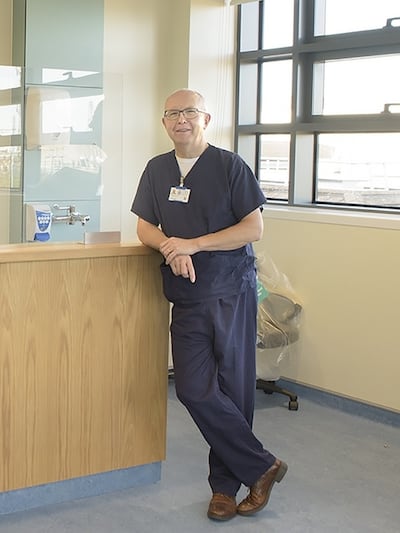When Mark Moore had to start dialysis in his early 30s due to polycystic kidney disease, he felt he had lost the battle with an inherited condition that he was diagnosed with as a child.
“Very scary” is how he recalls the prospect of having his first dialysis treatment on May 26th, 2021 in Dublin’s Tallaght University Hospital. It was a process he was familiar with, as his late father and aunt, as well as his uncle, had all needed dialysis for the disease, where clusters of cysts affect the functioning of the kidneys. However, he had to come to terms quite quickly with the realisation that it was “my turn”, when the decision regarding treatment was made during a Friday clinic appointment, and he had his first session the following Tuesday.
“But it was actually one of the best things that ever happened to me. I didn’t realise how sick I was and how under pressure I was. After my first dialysis, I was running the corridors of Tallaght ringing everybody telling everybody how good I felt. It was amazing.”
Due to the family history of the kidney disease, the now 36-year-old was tested for it at age 11 when receiving medical treatment for something else. His parents did not make a big deal of it with him at the time, so it was only when he started getting symptoms in his early 20s that it started to become an issue. “I played a lot of GAA football and I used to get a lot of bangs – I was a goalkeeper. I would rupture cysts and bleed out.” He also had to deal with high blood pressure, which “is just one of the things that come along with the disease”.
RM Block
The start of a dialysis regimen involved making the return journey from his home in Baltinglass, Co Wicklow, to Tallaght hospital three times a week, for three hours’ treatment each time. The HSE provides transport for dialysis patients, but it meant up to an hour on the road, depending on the traffic, each way, in addition to the time actually spent in the hospital.
It’s great to be able to do [home dialysis] in my sleep, because it doesn’t take away from my time for work or my time with my kids
— Mark Moore
“It was really affecting my workplace schedule,” says Moore, a process technician in pharmaceutical manufacturing, who works 12-hour day or night shifts in a 24-hour operation at Pfizer’s Grange Castle plant in Dublin. Having to go for dialysis meant he could no longer do that shift pattern. So when he was given the option of doing dialysis at home, he jumped at it.
At the hospital he had been on haemodialysis, during which blood is pulled out of the body to be filtered in a machine and then pumped back into the body. The filtering removes waste products and extra fluid from the blood, which is one of the jobs normally done by healthy kidneys producing urine in order to expel them from the body.
[ Orla Tinsley: The health system is not meeting its patients’ needsOpens in new window ]
The home treatment that Moore has been on since the end of 2021 is peritoneal dialysis, in which cleansing fluid is washed in and out through a tube inserted through the lining of the abdomen as he sleeps.
“I took to it like a duck to water,” he says. After about three training sessions in Tallaght and then a home visit by a team to set up the equipment in his house, all went smoothly, and there were no teething issues. At the beginning, a little drain pain might be experienced as fluid flows in, dwells there and then drains back out, he explains. One nightly session consists of five cycles of this and lasts eight hours.
“I started off on seven nights, and then they dropped me to six because my bloods were quite good.”

If he works the night shift, he will do the procedure as he sleeps during the day. Peritoneal dialysis has to be performed more frequently than haemodialysis, but is gentler on the body. He says he feels no after-effects at all, whereas the more intense haemodialysis would often leave him tired, drained and very hungry by the time he got home from the hospital.
The convenience of home dialysis is also a huge advantage for Moore, who has two young sons, Noah (5), and Ollie (3), with his wife Michelle.
Michelle, who he describes as “amazing”, plays a big part in making the home dialysis work for him, as she prepares the machine so he can go on it by 9pm, after coming home from a day shift at 8pm, to get sufficient time on it before leaving for work at 5.45am the next day. She then cleans the machine and disposes of the waste bag.
“It’s great to be able to do it in my sleep, because it doesn’t take away from my time for work or my time with my kids or going to football with my kids. I can live my life with this.”
He is one of just over 300 patients in Ireland who conduct their own dialysis at home. That represents roughly 12 per cent of dialysis patients. Prof George Mellotte, HSE national clinical lead for renal services and a consultant renal physician at Tallaght hospital, is determined to oversee an increase in that percentage.

He says it benefits both the patients and the health system.
A home dialysis patient not only avoids 150 lengthy hospital visits a year, often involving very long commutes, they also have more flexibility in deciding when to have the treatment (eg at night), have a lower risk of infection, and can bring equipment with them on holiday to continue this essential treatment. For the health service, the annual cost-saving for every patient who can manage their dialysis at home ranges from €30,000 to €50,000.
It’s a win-win then, yet home dialysis has, until recent years, been very underresourced, with little growth in numbers. The peritoneal method started back in the 1980s, while haemodialysis was introduced to the home therapies programme just over a decade ago. “But there wasn’t any what I would call a structure to it,” says Prof Mellotte. “I don’t mean this in any criticism, but it evolved organically. Sometimes it was foisted on people because there was no capacity in the hospital system.”
Despite the time-saving and convenience aspects, dialysis obviously results in more work at home for patients. Prof Mellotte compares it to self-catering versus a hotel experience. Those on centre-based dialysis are driven there and back from their homes; the machine is ready to go and a trained dialysis nurse runs the treatment, during which light snacks are available. A specialised doctor and dietitian are available if necessary.
With domestic dialysis, “the patient does all the work, and it brings the illness to the home”, he says. The patient needs to arrange deliveries, store supplies, set up the machine, clean it afterwards and dispose of the waste. The advantages of this approach were clearly heightened during the Covid-19 pandemic, however, when patient demand for home dialysis accelerated due to the fear of visiting hospitals.
Unless patients undergoing domestic treatment were better supported, they would drift back to centre-based treatment, argued Prof Mellotte in making the case for the development and funding of a modernised care pathway. The aim of this is to take more of the 2,500 people on dialysis out of in-centre treatment. According to HSE figures issued in March, of 2,502 patients then on dialysis, 1,461 were receiving it in a HSE hospital-based unit, 736 in HSE-contracted dialysis units, and 305 patients in their own home.
Improving supports for home-dialysis patients includes provision of more specialist nurses in regional units to help with training and occasional home visits. These patients also need the same access to dietitians when they attend hospital clinics, usually six times a year, as do their counterparts going into dialysis units thrice weekly.
Prof Mellotte also advocates nursing or healthcare assistant support for older, frailer patients, either to encourage them to start home dialysis or to help them continue with it when it gets physically more difficult for them to lift fluid and drain bags containing up to 14 litres of liquid. They may not have a family member to help them, or may not want to impose on them.
We’ve kept records since 2009, very detailed records, and we’re seeing a 3 per cent growth every year for the last 15 years
— Prof George Mellotte on incidence of chronic kidney disease
Other barriers to home dialysis include electricity costs, for which most people would have to be in employment to benefit from the available tax relief on income. Haemodialysis at home requires house alterations and essentially a dedicated room to accommodate the necessary machines and equipment. As of April 1st this year, there were 63 people on home haemodialysis, which they undergo typically every second day.
Although individual circumstances and medical complications mean home dialysis is not an option for many, Prof Mellotte says the aspiration is to move towards a national rate of 20 per cent of patients, a target that has already been met by the renal unit he heads in Tallaght. With an ageing population, the incidence of chronic kidney disease and failure will continue to rise. Two of the main causes are diabetes and hypertension. People who years ago would have died of heart disease are now surviving due to the insertion of stents, Prof Mellotte explains, but the same vascular factor, which affects the kidneys, is still there.

“We’ve kept records since 2009, very detailed records, and we’re seeing a 3 per cent growth every year for the last 15 years.”
Some 5,257 people with chronic kidney disease or failure were treated by dialysis or kidney transplantation in 2023, according to the HSE, an increase of 109 from the previous year.
[ Organ donation: ‘She’s like a different child. Sofia has her childhood back’Opens in new window ]
Some 191 kidney transplants were performed last year. They are “a different way of treating kidney failure”, explains Prof Mellotte. Although a transplant should greatly improve the recipient’s health and quality of life, it is not a cure. These individuals are likely to have a lot of the original complications, such as diabetes. “You still have to take lots of tablets. There’s a risk the disease might come back in the new kidney.”
Mark Moore has been on the transplant list for more than two years but he is temporarily off it as he prepares to have his right kidney, which has had a lot of infections, removed in July. This will leave his body in better shape to receive a transplant.
However, after this mid-summer nephrectomy, he will have to go back on hospital-based haemodialysis for eight to 10 weeks, “to give the one kidney a bit of help”.
After a period of post-surgery recovery, he should be able to resume peritoneal dialysis at home.
Moore says he has always been glad that he had experienced haemodialysis in hospital, and got to see that side of things.
“It humbled me an awful lot... and I really appreciate now to have the opportunity to be on peritoneal dialysis [at home]. I would highly recommend it.”
- Sign up for push alerts and have the best news, analysis and comment delivered directly to your phone
- Find The Irish Times on WhatsApp and stay up to date
- Listen to our Inside Politics podcast for the best political chat and analysis



















